Guillermo Bernárdez
Ordered Topological Deep Learning: a Network Modeling Case Study
Mar 20, 2025



Abstract:Computer networks are the foundation of modern digital infrastructure, facilitating global communication and data exchange. As demand for reliable high-bandwidth connectivity grows, advanced network modeling techniques become increasingly essential to optimize performance and predict network behavior. Traditional modeling methods, such as packet-level simulators and queueing theory, have notable limitations --either being computationally expensive or relying on restrictive assumptions that reduce accuracy. In this context, the deep learning-based RouteNet family of models has recently redefined network modeling by showing an unprecedented cost-performance trade-off. In this work, we revisit RouteNet's sophisticated design and uncover its hidden connection to Topological Deep Learning (TDL), an emerging field that models higher-order interactions beyond standard graph-based methods. We demonstrate that, although originally formulated as a heterogeneous Graph Neural Network, RouteNet serves as the first instantiation of a new form of TDL. More specifically, this paper presents OrdGCCN, a novel TDL framework that introduces the notion of ordered neighbors in arbitrary discrete topological spaces, and shows that RouteNet's architecture can be naturally described as an ordered topological neural network. To the best of our knowledge, this marks the first successful real-world application of state-of-the-art TDL principles --which we confirm through extensive testbed experiments--, laying the foundation for the next generation of ordered TDL-driven applications.
When Machine Learning Gets Personal: Understanding Fairness of Personalized Models
Feb 05, 2025



Abstract:Personalization in machine learning involves tailoring models to individual users by incorporating personal attributes such as demographic or medical data. While personalization can improve prediction accuracy, it may also amplify biases and reduce explainability. This work introduces a unified framework to evaluate the impact of personalization on both prediction accuracy and explanation quality across classification and regression tasks. We derive novel upper bounds for the number of personal attributes that can be used to reliably validate benefits of personalization. Our analysis uncovers key trade-offs. We show that regression models can potentially utilize more personal attributes than classification models. We also demonstrate that improvements in prediction accuracy due to personalization do not necessarily translate to enhanced explainability -- underpinning the importance to evaluate both metrics when personalizing machine learning models in critical settings such as healthcare. Validated with a real-world dataset, this framework offers practical guidance for balancing accuracy, fairness, and interpretability in personalized models.
TopoTune : A Framework for Generalized Combinatorial Complex Neural Networks
Oct 09, 2024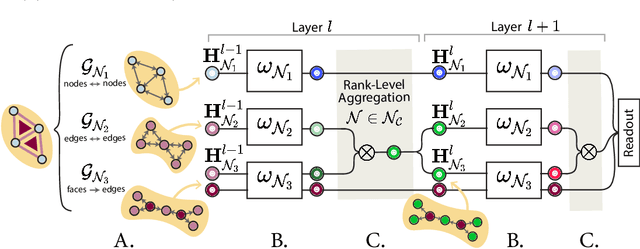
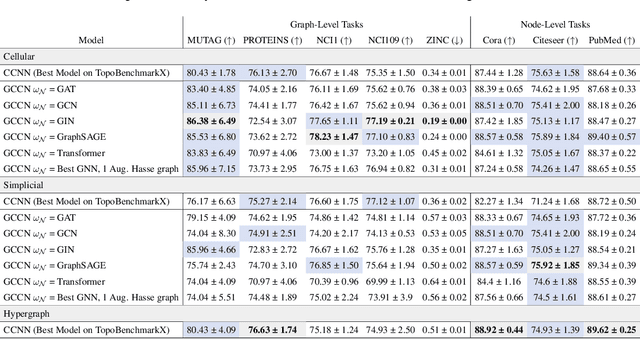


Abstract:Graph Neural Networks (GNNs) excel in learning from relational datasets, processing node and edge features in a way that preserves the symmetries of the graph domain. However, many complex systems--such as biological or social networks--involve multiway complex interactions that are more naturally represented by higher-order topological spaces. The emerging field of Topological Deep Learning (TDL) aims to accommodate and leverage these higher-order structures. Combinatorial Complex Neural Networks (CCNNs), fairly general TDL models, have been shown to be more expressive and better performing than GNNs. However, differently from the graph deep learning ecosystem, TDL lacks a principled and standardized framework for easily defining new architectures, restricting its accessibility and applicability. To address this issue, we introduce Generalized CCNNs (GCCNs), a novel simple yet powerful family of TDL models that can be used to systematically transform any (graph) neural network into its TDL counterpart. We prove that GCCNs generalize and subsume CCNNs, while extensive experiments on a diverse class of GCCNs show that these architectures consistently match or outperform CCNNs, often with less model complexity. In an effort to accelerate and democratize TDL, we introduce TopoTune, a lightweight software that allows practitioners to define, build, and train GCCNs with unprecedented flexibility and ease.
ICML Topological Deep Learning Challenge 2024: Beyond the Graph Domain
Sep 08, 2024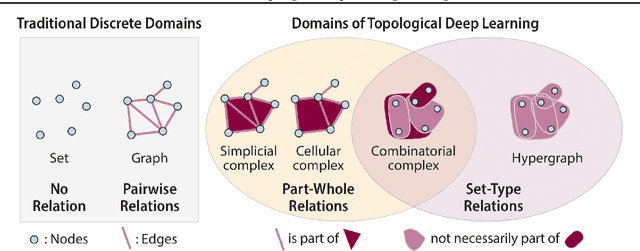
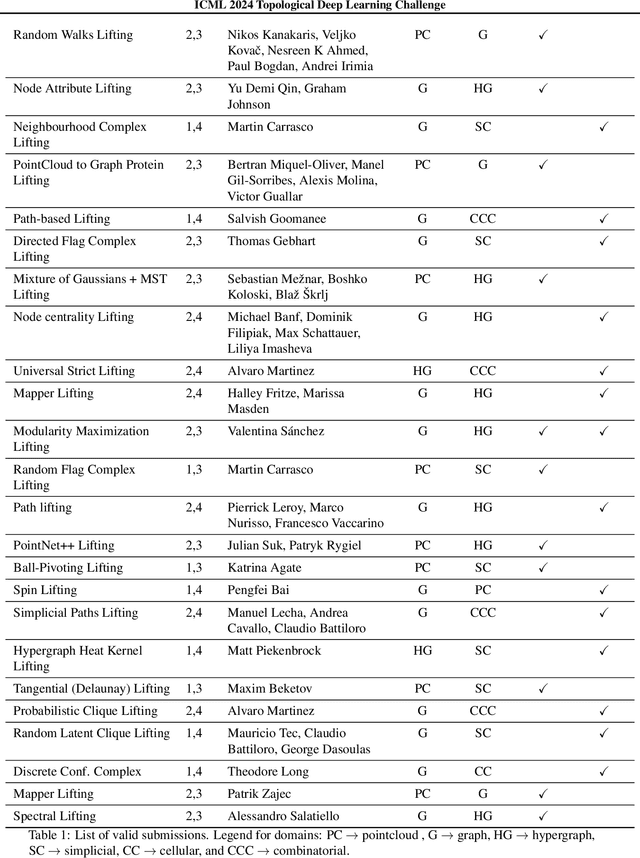
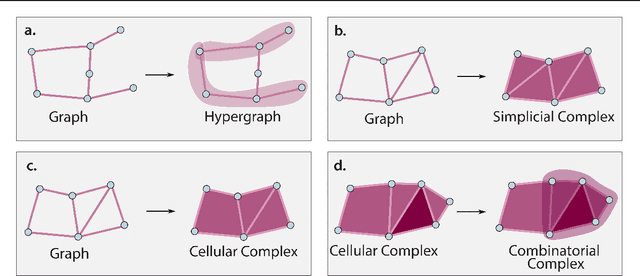
Abstract:This paper describes the 2nd edition of the ICML Topological Deep Learning Challenge that was hosted within the ICML 2024 ELLIS Workshop on Geometry-grounded Representation Learning and Generative Modeling (GRaM). The challenge focused on the problem of representing data in different discrete topological domains in order to bridge the gap between Topological Deep Learning (TDL) and other types of structured datasets (e.g. point clouds, graphs). Specifically, participants were asked to design and implement topological liftings, i.e. mappings between different data structures and topological domains --like hypergraphs, or simplicial/cell/combinatorial complexes. The challenge received 52 submissions satisfying all the requirements. This paper introduces the main scope of the challenge, and summarizes the main results and findings.
TopoX: A Suite of Python Packages for Machine Learning on Topological Domains
Feb 07, 2024
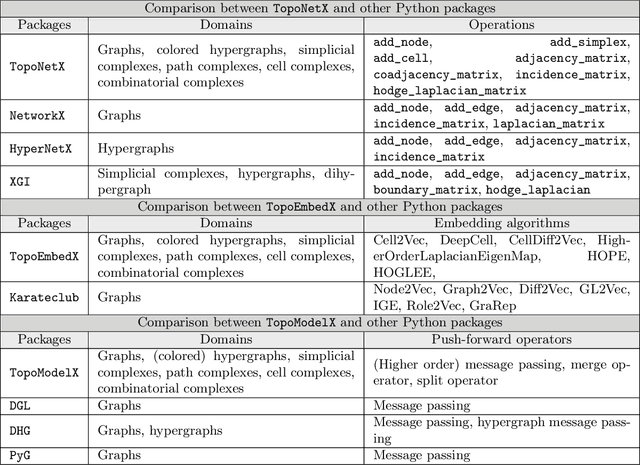
Abstract:We introduce topox, a Python software suite that provides reliable and user-friendly building blocks for computing and machine learning on topological domains that extend graphs: hypergraphs, simplicial, cellular, path and combinatorial complexes. topox consists of three packages: toponetx facilitates constructing and computing on these domains, including working with nodes, edges and higher-order cells; topoembedx provides methods to embed topological domains into vector spaces, akin to popular graph-based embedding algorithms such as node2vec; topomodelx is built on top of PyTorch and offers a comprehensive toolbox of higher-order message passing functions for neural networks on topological domains. The extensively documented and unit-tested source code of topox is available under MIT license at https://github.com/pyt-team.
Topological Graph Signal Compression
Aug 21, 2023Abstract:Recently emerged Topological Deep Learning (TDL) methods aim to extend current Graph Neural Networks (GNN) by naturally processing higher-order interactions, going beyond the pairwise relations and local neighborhoods defined by graph representations. In this paper we propose a novel TDL-based method for compressing signals over graphs, consisting in two main steps: first, disjoint sets of higher-order structures are inferred based on the original signal --by clustering $N$ datapoints into $K\ll N$ collections; then, a topological-inspired message passing gets a compressed representation of the signal within those multi-element sets. Our results show that our framework improves both standard GNN and feed-forward architectures in compressing temporal link-based signals from two real-word Internet Service Provider Networks' datasets --from $30\%$ up to $90\%$ better reconstruction errors across all evaluation scenarios--, suggesting that it better captures and exploits spatial and temporal correlations over the whole graph-based network structure.
GraphCC: A Practical Graph Learning-based Approach to Congestion Control in Datacenters
Aug 09, 2023



Abstract:Congestion Control (CC) plays a fundamental role in optimizing traffic in Data Center Networks (DCN). Currently, DCNs mainly implement two main CC protocols: DCTCP and DCQCN. Both protocols -- and their main variants -- are based on Explicit Congestion Notification (ECN), where intermediate switches mark packets when they detect congestion. The ECN configuration is thus a crucial aspect on the performance of CC protocols. Nowadays, network experts set static ECN parameters carefully selected to optimize the average network performance. However, today's high-speed DCNs experience quick and abrupt changes that severely change the network state (e.g., dynamic traffic workloads, incast events, failures). This leads to under-utilization and sub-optimal performance. This paper presents GraphCC, a novel Machine Learning-based framework for in-network CC optimization. Our distributed solution relies on a novel combination of Multi-agent Reinforcement Learning (MARL) and Graph Neural Networks (GNN), and it is compatible with widely deployed ECN-based CC protocols. GraphCC deploys distributed agents on switches that communicate with their neighbors to cooperate and optimize the global ECN configuration. In our evaluation, we test the performance of GraphCC under a wide variety of scenarios, focusing on the capability of this solution to adapt to new scenarios unseen during training (e.g., new traffic workloads, failures, upgrades). We compare GraphCC with a state-of-the-art MARL-based solution for ECN tuning -- ACC -- and observe that our proposed solution outperforms the state-of-the-art baseline in all of the evaluation scenarios, showing improvements up to $20\%$ in Flow Completion Time as well as significant reductions in buffer occupancy ($38.0-85.7\%$).
MAGNNETO: A Graph Neural Network-based Multi-Agent system for Traffic Engineering
Mar 31, 2023



Abstract:Current trends in networking propose the use of Machine Learning (ML) for a wide variety of network optimization tasks. As such, many efforts have been made to produce ML-based solutions for Traffic Engineering (TE), which is a fundamental problem in ISP networks. Nowadays, state-of-the-art TE optimizers rely on traditional optimization techniques, such as Local search, Constraint Programming, or Linear programming. In this paper, we present MAGNNETO, a distributed ML-based framework that leverages Multi-Agent Reinforcement Learning and Graph Neural Networks for distributed TE optimization. MAGNNETO deploys a set of agents across the network that learn and communicate in a distributed fashion via message exchanges between neighboring agents. Particularly, we apply this framework to optimize link weights in OSPF, with the goal of minimizing network congestion. In our evaluation, we compare MAGNNETO against several state-of-the-art TE optimizers in more than 75 topologies (up to 153 nodes and 354 links), including realistic traffic loads. Our experimental results show that, thanks to its distributed nature, MAGNNETO achieves comparable performance to state-of-the-art TE optimizers with significantly lower execution times. Moreover, our ML-based solution demonstrates a strong generalization capability to successfully operate in new networks unseen during training.
Proximal Policy Optimization with Graph Neural Networks for Optimal Power Flow
Dec 23, 2022



Abstract:Optimal Power Flow (OPF) is a very traditional research area within the power systems field that seeks for the optimal operation point of electric power plants, and which needs to be solved every few minutes in real-world scenarios. However, due to the nonconvexities that arise in power generation systems, there is not yet a fast, robust solution technique for the full Alternating Current Optimal Power Flow (ACOPF). In the last decades, power grids have evolved into a typical dynamic, non-linear and large-scale control system, known as the power system, so searching for better and faster ACOPF solutions is becoming crucial. Appearance of Graph Neural Networks (GNN) has allowed the natural use of Machine Learning (ML) algorithms on graph data, such as power networks. On the other hand, Deep Reinforcement Learning (DRL) is known for its powerful capability to solve complex decision-making problems. Although solutions that use these two methods separately are beginning to appear in the literature, none has yet combined the advantages of both. We propose a novel architecture based on the Proximal Policy Optimization algorithm with Graph Neural Networks to solve the Optimal Power Flow. The objective is to design an architecture that learns how to solve the optimization problem and that is at the same time able to generalize to unseen scenarios. We compare our solution with the DCOPF in terms of cost after having trained our DRL agent on IEEE 30 bus system and then computing the OPF on that base network with topology changes
Is Machine Learning Ready for Traffic Engineering Optimization?
Sep 03, 2021
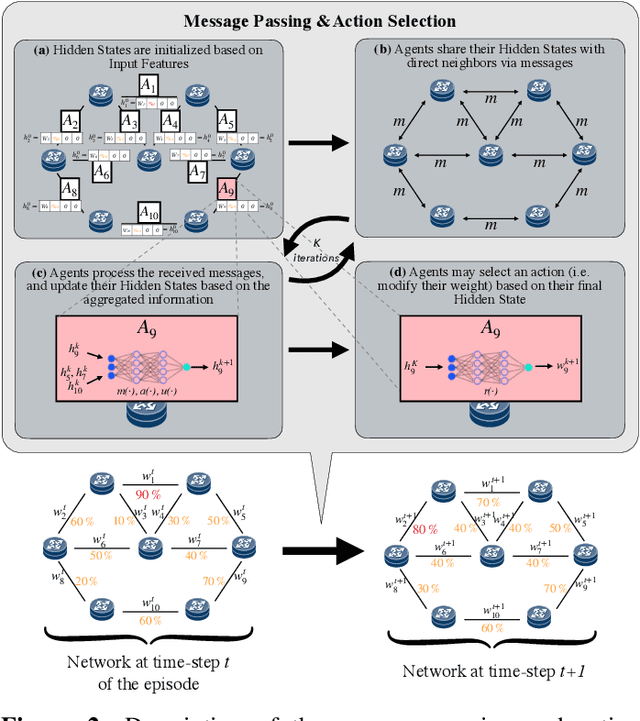
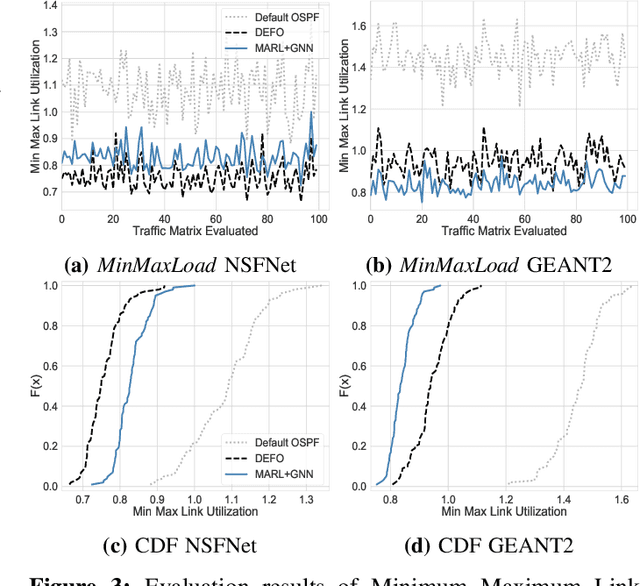
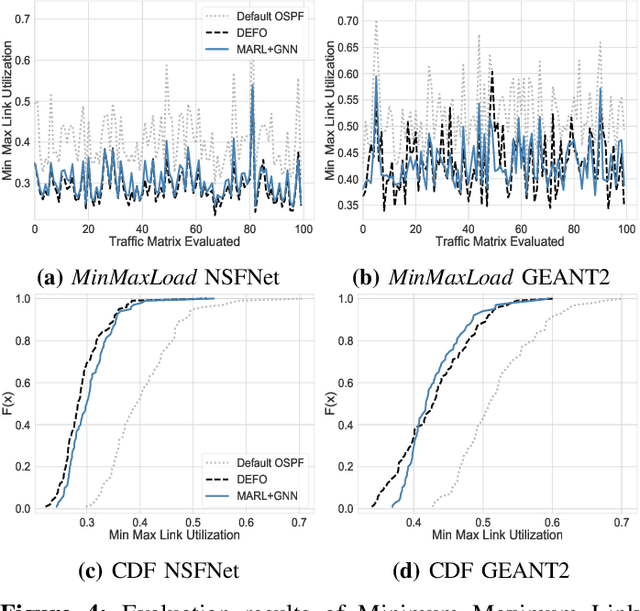
Abstract:Traffic Engineering (TE) is a basic building block of the Internet. In this paper, we analyze whether modern Machine Learning (ML) methods are ready to be used for TE optimization. We address this open question through a comparative analysis between the state of the art in ML and the state of the art in TE. To this end, we first present a novel distributed system for TE that leverages the latest advancements in ML. Our system implements a novel architecture that combines Multi-Agent Reinforcement Learning (MARL) and Graph Neural Networks (GNN) to minimize network congestion. In our evaluation, we compare our MARL+GNN system with DEFO, a network optimizer based on Constraint Programming that represents the state of the art in TE. Our experimental results show that the proposed MARL+GNN solution achieves equivalent performance to DEFO in a wide variety of network scenarios including three real-world network topologies. At the same time, we show that MARL+GNN can achieve significant reductions in execution time (from the scale of minutes with DEFO to a few seconds with our solution).
 Add to Chrome
Add to Chrome Add to Firefox
Add to Firefox Add to Edge
Add to Edge